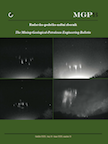Selected results of determining the friction interaction coefficient between crushed stone and polyester strip
DOI:
https://doi.org/10.17794/rgn.2017.4.4Abstract
In the past twenty years in Croatia, a number of reinforced earth constructions have been built, of which two reinforced earth walls stand out due to their dimensions: Strikići and Sveta Trojica. In the building of these walls, polyester strips were used as reinforcement elements, whereas as fi ll material crushed stone aggregate was used. For designing these constructions, knowledge about the interaction mechanisms between the polyester strip and the soil is required. So far, most of the published studies have been directed to the determination of the friction interaction coeffi cient of the poly-ester strip and the fi ll material which was sand or gravel, whereas tests on the interaction between the geosynthetic strip and the crushed stone aggregate have not been performed. In order to determine the friction interaction coeffi cient between the crushed stone aggregate which is commonly used as fi ll material and the geosynthetic strip, pull-out tests of the polyester strip were carried out. Apart from pull-out tests, large direct shear tests were performed to determine shear strength parameters of crushed stone strength. Predictions from the numerical model were compared to a series of pull-out tests, proving that the numerical model provides reasonable predictions of pull-out behavior.
Downloads
Published
Versions
- 2023-09-25 (2)
- 2017-10-10 (1)
How to Cite
Issue
Section
License
Copyright (c) 2017 Rudarsko-geološko-naftni zbornik

This work is licensed under a Creative Commons Attribution 4.0 International License.
Creative Commons-BY
Authors who publish with this journal agree to the following terms:
In agreeing this form, you certify that:
- You read the ethical codex of the RGN zbornik available at journal web.
- You submitted work is your original work, and has not previously been published and does not include any form of plagiarism.
- You own copyright in the submitted work, and are therefore permitted to assign the licence to publish to RGN zbornik.
- Your submitted work contains no violation of any existing copyright or other third party right or any material of an obscene, libellous or otherwise unlawful nature.
- You have obtained permission for and acknowledged the source of any illustrations, diagrams or other material included in the work of which you are not the copyright owner.
- You have taken due care to ensure the accuracy of the work, and that, to the best of your knowledge, there are no false statements made within it.
- All co-authors of this submitted work are aware of, and in agreement with, the terms of this licence and that the submitted manuscript has been approved by these authors.
Publication licence
You retain copyright in your submitted work, according to journal license policy (CC-BY). By signing this form you agree that RGN zbornik may publish it under the publication licence. In summary the licence allows the following:
Anyone is free:
- To copy, distribute, display, and perform the work.
- To make derivative works.
Under the following conditions:
- The original author must always be given credit.
- The work may not be used for commercial purposes.
- If the work is altered, transformed, or built upon, the resulting work may only be distributed under a licence identical to this one.
Exceptions to the licence
In addition to publishing the work printed under the above licence, RGN zbornik will also enable the work to be visible online.
The journal editorial can change the licence rules anytime but it cannot retroactively restrict author(s) rights.


